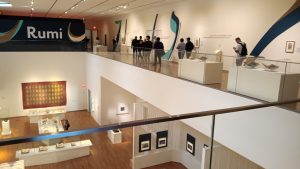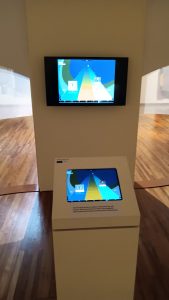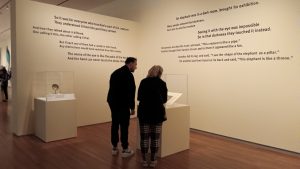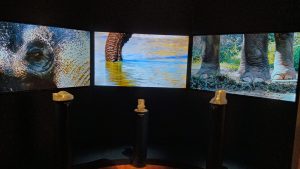Interactive display technology, digital 3D printing, and the ever-present influence of social media are integrated into a new museum exhibition exploring the life and work of a 13th century poet, Islamic scholar and Sufi mystic.
On the 750th anniversary of his passing, the exhibition at the Aga Khan Museum in Toronto explores the life and legacy of Jalal al-Din Muhammad of Balkh, otherwise known as Rumi.
Rumi’s influence on arts and culture – yesterday’s and today’s – is revealed in this eye-catching exhibition that both introduces and explores Rumi’s work through historic masterpieces and contemporary commissions.

On the 750th anniversary of his passing, an exhibition at the Aga Khan Museum in Toronto explores the life and legacy of Jalal al-Din Muhammad of Balkh, otherwise known as Rumi. Photos by Lee Rickwood.
The exhibition – simply titled Rumi – is divided into three main sections, The Historical Rumi, The Visual Rumi, and Rumi in Translation, and it takes visitors on an engaging visual journey recreating the impact of his written word and his conveyance of messages of love and inner transformation.
Many of those messages – his oft-cited quotes and sayings – have found their way into our modern culture and social media-ted world, having been echoed (and tattooed) by entertainment icons and pop culture megastars like Brad Pitt, Beyoncé, and Coldplay.
* * *
Rumi’s mystical writings have been reinterpreted for audiences across many centuries and languages, and 750 years later, his core messages of peace and love are still relevant, universal, and impactful.
“The exhibition celebrates the joy, love, and connectedness that Rumi’s words have inspired over the past eight centuries, including today, when one of the most important ways that people have come to know about Rumi’s poetry and teachings is through social media,” explained curator Dr. Michael Chagnon in an online exchange with WhatsYourTech. “In fact, quotes by, or attributed to, Rumi appear everywhere on Facebook, Instagram, Twitter and TikTok! It would be an incredible thing for people who are social media savvy—and who enjoy the Rumi quotes that come across their screens—to realize how they themselves continue a long legacy of reading and appreciating Rumi.”

“Our idea in partnering with TMU Libraries on the interventions was to create layers of digital engagement throughout the exhibition,” said exhibition curator, Dr. Michael Chagnon.
The exhibition offers a thoughtful investigation of the historical and literary context of those words, he described, using the printed word and the interactive screen.
* * *
In fact, the exhibition explores Rumi’s words on screens placed in interactive media stations developed in partnership with Toronto Metropolitan University Libraries.
Each station provides additional layers of interpretation, focusing on Rumi’s place in global history, Dr. Chagnon noted.
“Our idea in partnering with TMU Libraries on the interventions was to create layers of digital engagement throughout the exhibition that delivered information that could not be experienced by just a simple label on the wall, no matter how informative those labels might be.”
* * *
Among the labelled historic manuscripts, master’s paintings, and cultural artifacts from the Aga Khan Museum’s Collections shared in this exhibition is a rare, illustrated copy of Rumi’s Masnavi; it’s one of the most renowned works of Sufi poetry and a landmark of world literature.
In one of its nearly 25,000 verses, Rumi reflects on the universal power of love with insight, tenderness and, yes, technology makes an appearance:
The lover’s cause is separate from all other causes
Love is the astrolabe of God’s mysteries.
(The astrolabe is an ancient astronomical instrument that served up a handheld model of the universe; it presented a two-dimensional depiction of the heavens using a mathematical technique we might today call stereographic projection. Like VR in the 13th century!)
So, technology has long supported Rumi’s mystic vision of God’s love and human nature.
* * *
In addition to the many historic objects on display, the exhibition features three modern pieces by Canadian-based contemporary and multimedia artists who have been deeply inspired by Rumi’s poetry.
One piece presents a distinctive high-tech take on a particular Rumi poem that highlights how important it is for us to have, and use, different perspectives.

A poem by Rumi highlights how important it is for us to see, have, and use different perspectives. It’s printed on a museum display wall, and illustrated in an interactive video installation.
Printed nearby on a facing wall, the poem describes how selectively, separately, and perhaps incorrectly, people who have never encountered or even heard of an elephant would describe it – if their first encounter was in the dark. Is the tail a snake? Are the elephant’s legs tree trunks? And what is that thing up front?!?
Based on the poem of the same name, The Elephant in the Dark uses touch-based technology to let visitors trigger a sense of playful, curious wonder about the animal.
Created by Iranian-Canadian multimedia artist Simin Keramati, giant high-resolution video screens show highly stylized and extreme close-up shots of different parts of an elephant’s body. She took great care while enhancing the stock footage she acquired online, adding colour saturation and contrast to the images, manipulating speed, and recreating the audio track.

Created by Iranian-Canadian multimedia artist Simin Keramati, The Elephant in the Dark uses touch-based interactive technology to let visitors trigger a sense of playful, curious wonder about the animal.
Visitors can select and start specific video sequences by means of unique, three-dimensional elephant body part sculptures, each designed in reduced scale and specifically printed for the exhibition using translucent material and a 3D printer.
The majestic elephant only appears in full size in another video sequence, playing on another screen nearby; until then, our perception and our knowledge of the animal is limited. Are we fully human if we limit ourselves? Is our judgment limited by our limited perceptions, the visitor wonders, or by our technology?
“[E]ven with its big HD screens and touch-activated elements, Simin’s installation engages with Rumi in an incredibly subtle way,” Dr. Chagnon described. “It focuses the visitor on the limitations of sensory perception and the cultivation of knowledge in the heart, which is a theme that recurs throughout Rumi’s poetry.
“Our goal in commissioning Elephant in the Dark and the two other contemporary installations (Distance between Homes by Hangama Amiri and The Dream that Must Be Interpreted by Erdem Taşdelen) was to highlight how contemporary artists, including those who use multimedia technology, continue to be deeply inspired by Rumi.”
As will exhibition visitors, even after their trip to the Aga Khan Museum: the exhibition reinforces both the inspirational impact of Rumi’s words and the timelessness of his teachings, be it through the power of an historic 13th century artifact or a modern-day social media post.
# # #

Listen is an art installation emerging out of the centre reflective pool in the Aga Khan Park. Inspired by words attributed to Rumi, Matt Donovan and Hallie Siegal’s installation appears as a jumble of upside-down letters, inviting visitors to decipher its meaning through reflections in the water.
-30-
More Articles on Aga Khan Museum



